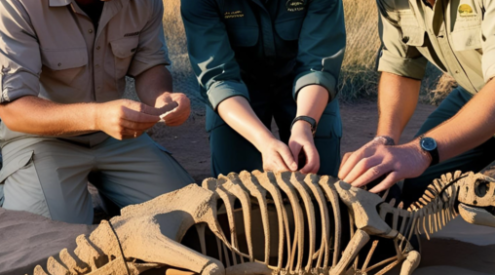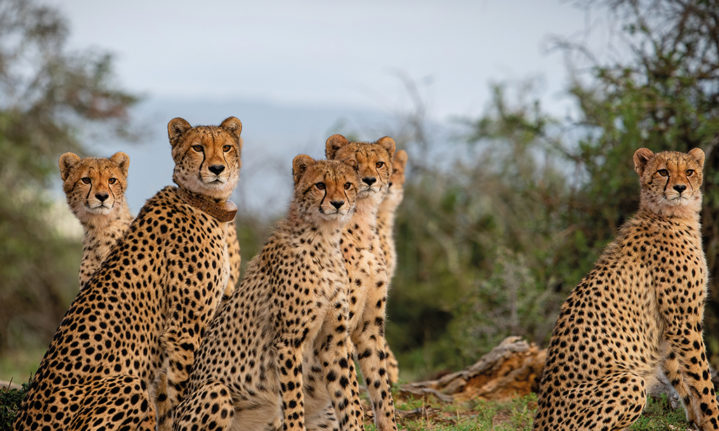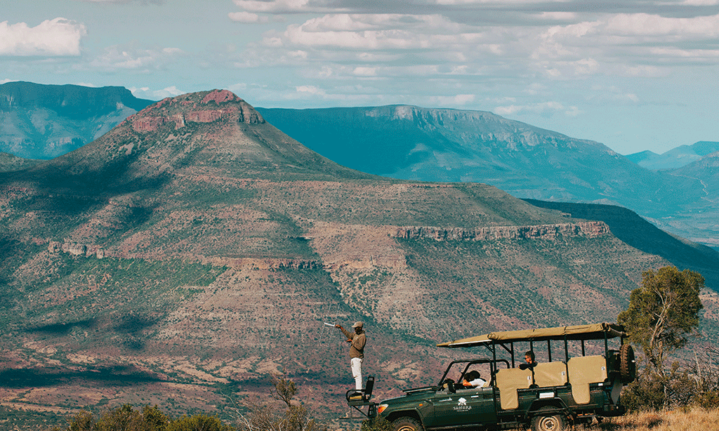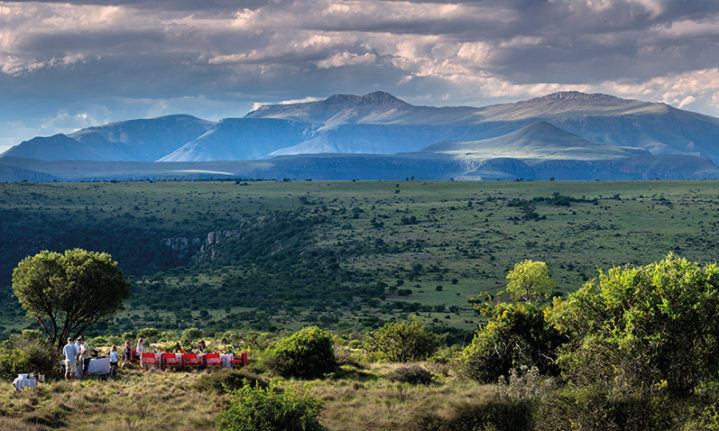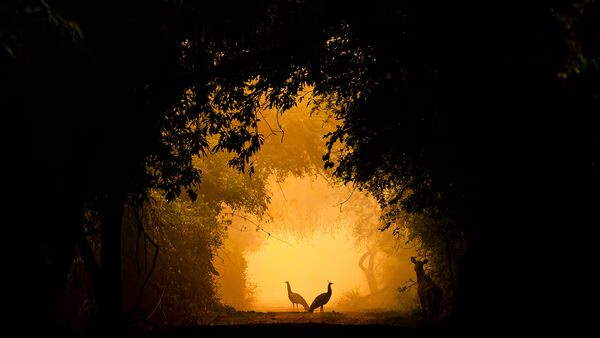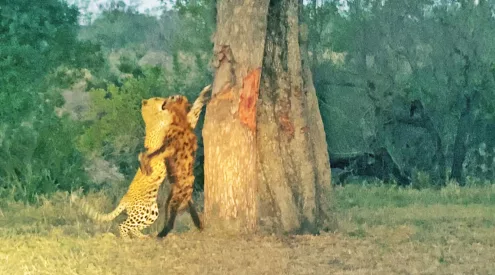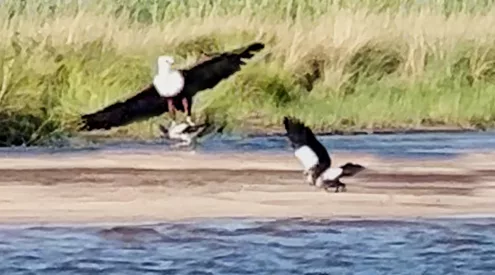Di Brown heads to Samara Private Game Reserve to discover a new development in the lives of its legendary cheetahs.
Photography: supplied
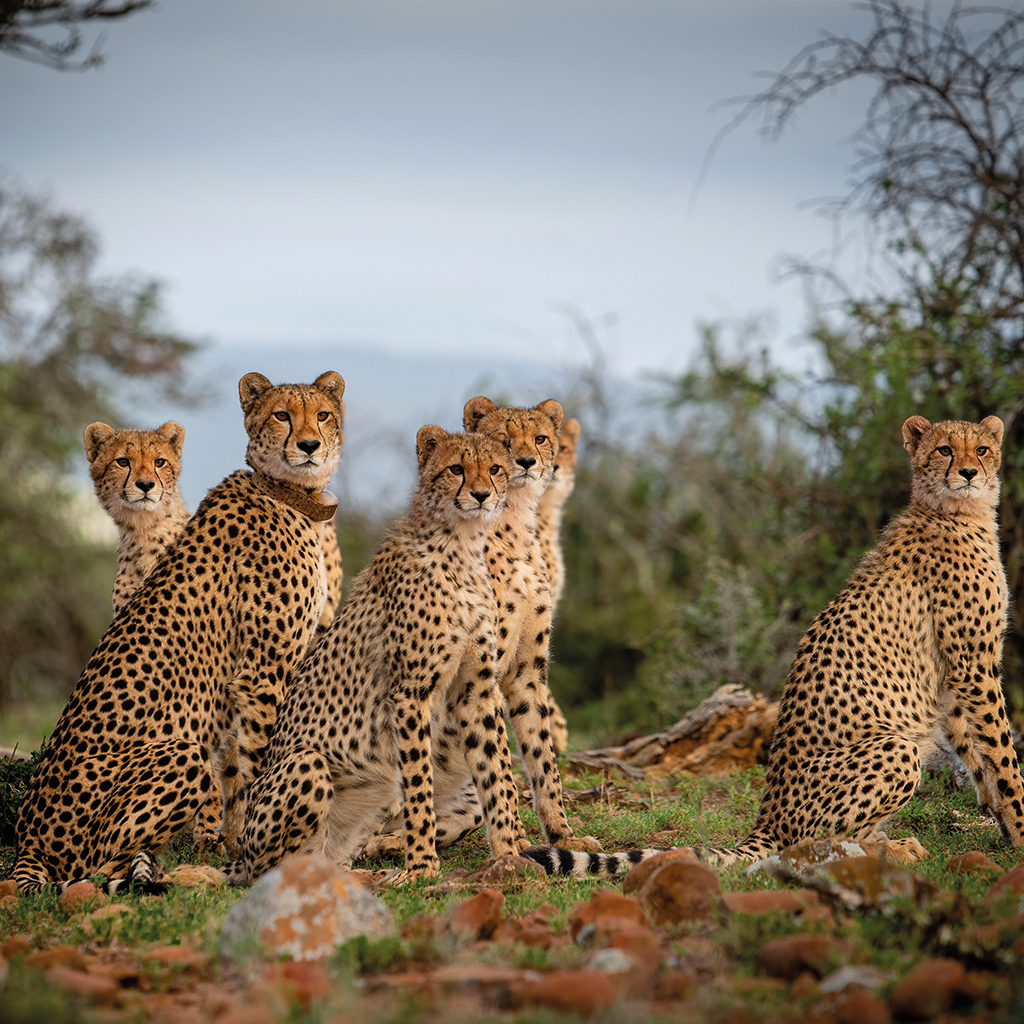
What was that? Chilli and some of the cubs, curious, as all cats are. (Photo David Niederberger)
I know these cheetahs. I have tracked them on foot several times, crouched down a mere 30 metres from Chilli, daughter of the legendary Sibella, and her cubs, utterly captivated. I also know what any reputable field guide will tell you: cheetahs are solitary cats, and while males might group together in coalitions – the collective noun for male cheetahs – the females roam alone except when raising cubs, which takes about 15 months. So, what is this talk of prides?
Could this be a pride or are we prejudiced?
The cheetahs at Samara Private Game Reserve in the Great Karoo have been closely monitored using very high frequency radio collars since 2004.
In early April last year, Chilli had a litter of five cubs and in late April, Inara, who is Chilli’s daughter, had a litter of four. The way of nature would be for them to stay in their own ranges on the Samara Reserve.
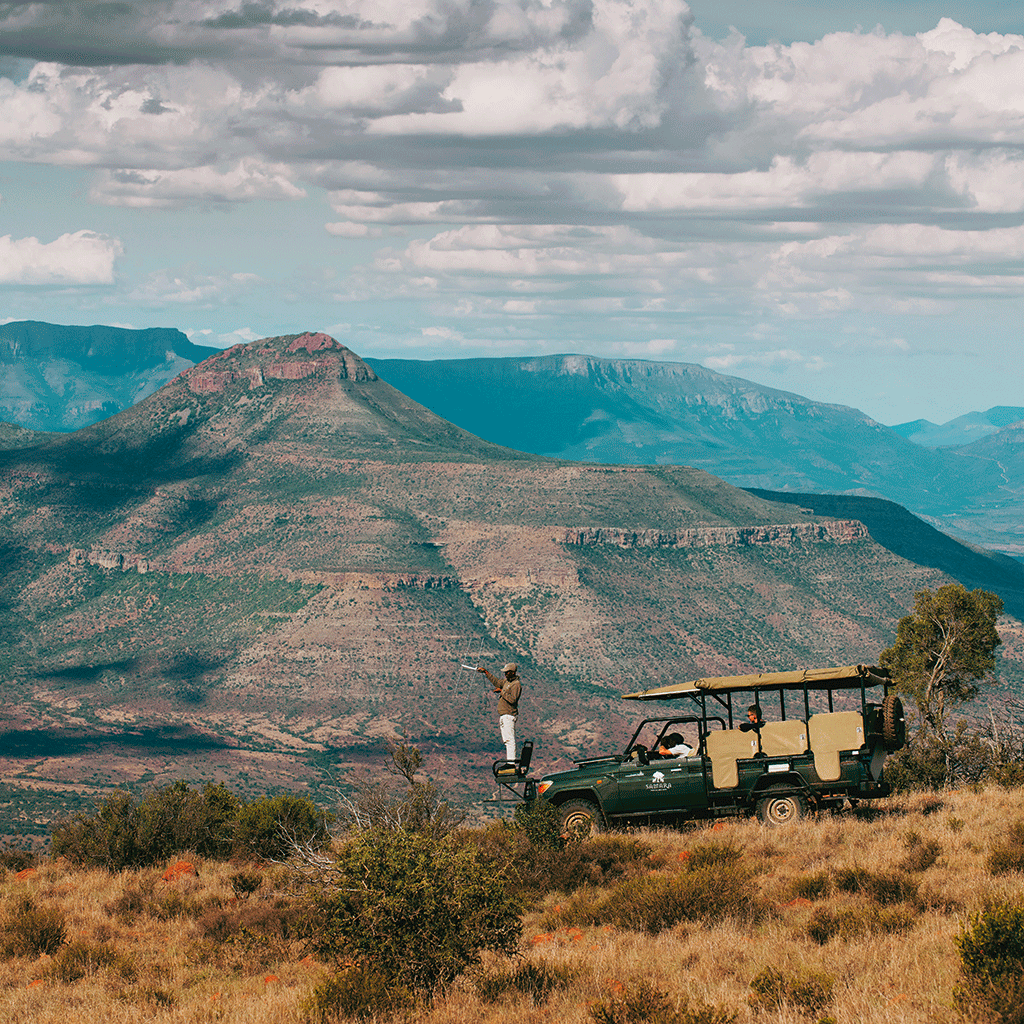
Searching for the cheetahs. A ranger holds up the antenna to pick up a signal from the radio collar.
Filmmaker Hansa Winshaw takes up the story. ‘On the 17th of June we were walking east into the rising sun along a ridge with Chilli and her five cubs when we found Inara and her four cubs traversing west. Chilli and Inara hissed and took a few swipes at each other, sending the cubs scattering into the bushes,’ he says. ‘In no time the cubs were mixed together and eventually, the two mothers retired to the shade with the cubs to wait out the heat. When Chilli and Inara left later that day, heading east and west respectively, two of Chilli’s cubs went with Inara. The following morning, we were surprised to see Inara allowing both these cubs to suckle.’
What transpired over the next three months, captured on film by Winshaw, is like a scientific soap opera with the cheetahs as the stars of the show.
A stellar cast
There were a number of cheetah ‘meet and greets’, the interactions ranging from brief non-confrontational encounters showing a willingness to share ranges, moving through the reserve together as a group, to co-operative hunting, where the mothers ate separately but both allowed all the cubs to share in the spoils.
Marnus Ochse, general manager of Samara, had to see for himself.
‘I could not believe my eyes. Walking through the bush together were two females and nine cubs. They were like a pack or pride of cheetahs. It was an incredible sight to witness,’ says Marnus.
Then Chilli got injured. A tusk or horn ripped open a wound that extended from her armpit to her belly and ultimately resulted in 30 stitches.
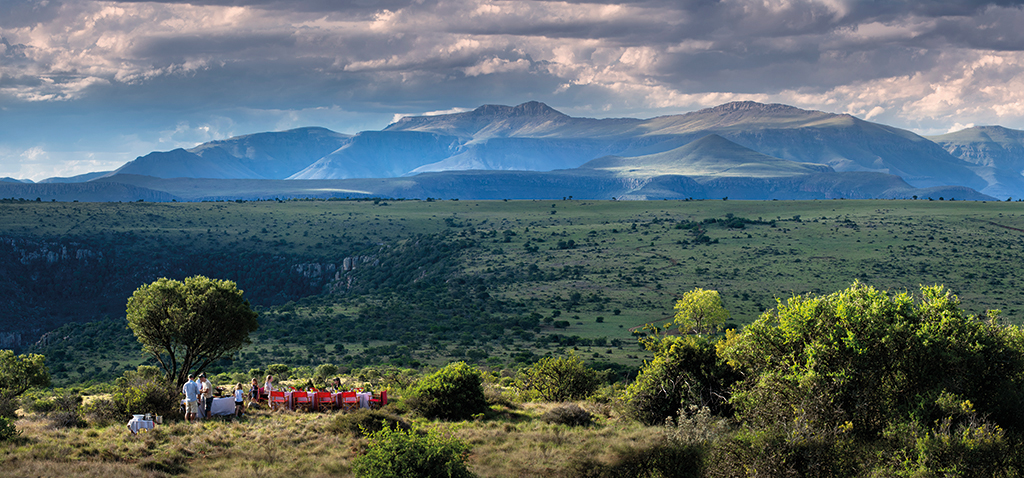
A picnic on the Samara ‘Mara Plain’ is a wonderful way to enjoy this remarkable environment.
Cheetahs use speed and wide angle, long distance vision for hunting. They also have a complex system of communication, leaving “messages” by rubbing or leaving claw marks, scent from saliva, urine or scat on and around trees. Pertinent to the story is the fact that Inara only has one eye. This is why, although she is Chilli’s daughter, she was allowed to remain at Samara, where the terrain is familiar to her. Usually, cheetahs born on Samara are moved to another reserve as part of the Endangered Wildlife Trust’s Cheetah Metapopulation Project, to ensure genetic diversity within the population.
Amazingly, Inara returned to Chilli when she was in need and helped provide for the “pride”.
Chilli recovered, Inara went off with a few cubs, not all her own, and this grouping remained for a few weeks. Cubs were lost, cubs were found and ultimately Chilli adopted all the cubs, taking on the mammoth task of raising and feeding nine youngsters.
This behaviour is known as allo-mothering, or when the young are cared for by a non-maternal female. Best known in elephants, who form matriarchal herds, it is a way of teaching mothering skills while strengthening the bond of the group. It is the last thing you would expect to see in a species that prefers to go it alone.
The scientific implications are being studied by Professor Graham Kerley, the director of the Centre for African Conservation Ecology at Nelson Mandela University.
‘These observations raise a range of questions as to why these cheetah females are taking care of cubs other than their own. It could be a special case that reflects the relatedness of the two mothers, who are essentially “aunts” to each other’s cubs. Or is this just a case of confused cubs and mothers?’ asks Kerley. ‘It challenges much of our understanding about cheetah social structure and how female cheetahs can interact.’
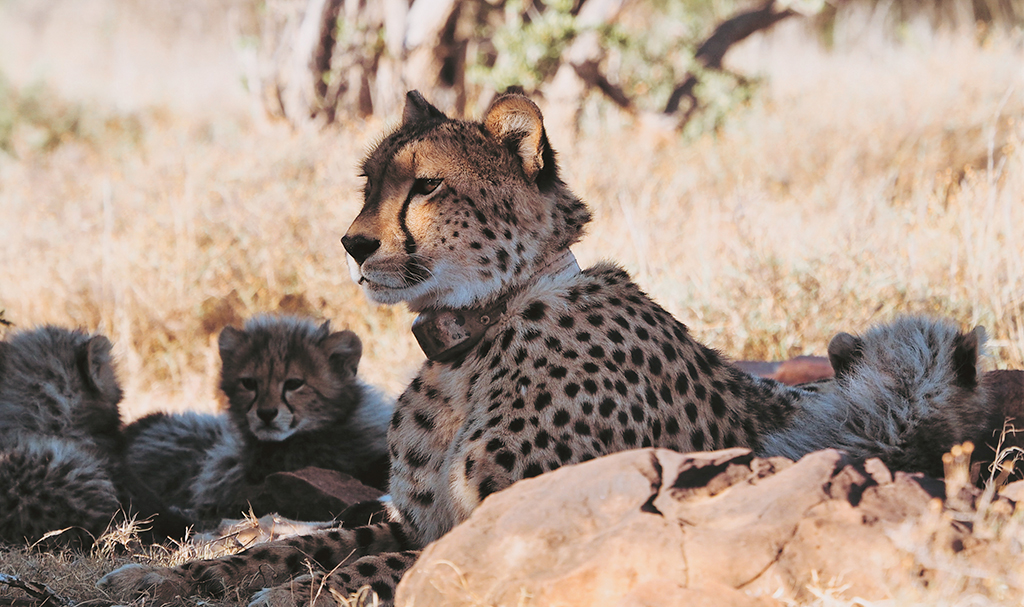
Chilli and her cubs happy to have found a bit of shade.
What does it mean for science and conservation?
‘Recognising that cheetah females are not necessarily trapped in the “single mother” situation, but may assist each other in raising cubs, opens new avenues to exploring cheetah sociality and also how we could use this to better conserve cheetahs. If cheetah females will care for strange cubs, it may obviate the need for hand-raising orphaned cubs, which is expensive and leads to challenges when these animals must be released back into the wild. Clearly, we need better science on cheetah sociality to explore these options,’ explains Kerley.
To date, Chilli continues the allo-mothering and is doing a great job as the cubs are now starting to hunt alone, having success with springbok and warthog.
Hansa continues to film Chilli and the cubs every morning and evening, a task he relishes.
‘It’s been an absolute rollercoaster, and I am in awe of everything these cats have been through and overcome. Documenting the allo-mothering and watching the cubs grow up through my lens has been an indescribable privilege,’ he says.
The scientific support team at Samara will be producing a paper on the allo-mothering, continuing the ongoing contribution by the reserve to conservation science. Follow Samara on social media to see how this story unfolds, or book a stay there and say “yes” to cheetah tracking. Who knows, you might just see a pride of them.
Cheetah conservation
Cheetahs are highly endangered with only about 7 100 remaining worldwide. South Africa is one of the few conservation success stories. The cheetah population has increased from 400 animals in 1965 to almost 1 300 today. The Endangered Wildlife Trust’s Cheetah Metapopulation Project (CMP) in southern Africa was started in 2011 and ensures the genetic health of cheetahs by managing them as one population spread over numerous reserves. ‘Samara is one of the best performing metapopulation reserves, and about 30% of meta-population cheetahs can trace their genetic origins to cheetahs that come from Samara,’ says Vincent van der Merwe, manager of the CMP.
In December 2003, after an absence of 125 years, cheetahs were returned to the Great Karoo at Samara. The female was Sibella, a legend who survived being beaten and caged after a vicious attack by hunting dogs when she was just two years old. She was rescued by the then De Wildt Cheetah and Wildlife Trust, which managed to save and rehabilitate her. She was then relocated with two rescued males to Samara where she thrived until her death in 2015. Sibella’s legacy lives on in the South African cheetah metapopulation. She had 19 cubs and her bloodline is now in its fourth generation. Her genes are in 25 distinct populations across southern Africa, which include her daughter, Chilli, and granddaughter, Inara, at Samara.
Hansa Winshaw – Filmmaker
Hansa Winshaw is a director/producer and cinematographer whose contribution to cheetah conservation is by telling the story from their perspective. Involved in the film Sibella, The Miracle Cheetah a few years ago, he returned to Samara during lockdown to film the allo-mothering behaviour.
The Tech
Very high frequency radio collars are attached to the cheetahs for monitoring. Non-invasive to the animal, they do not weigh more than 4–5% of the cheetah’s body weight and have
a battery life of about three years. The tracker uses a receiver and directional antenna to locate their position.
At Samara, tracking has provided valuable insight into the territory covered, time of day the cheetahs move around, what and where they kill, where they give birth, and the unusual allo-mothering behaviour.

Stay Here
Samara Private Game Reserve near Graaff-Reinet was established in 1997. Today Samara is 67 000 acres of mountains, plains, thickets, and grasslands where the Big 5, cheetah and an abundance of other wildlife exists. There is a South African residents special of R3 750 per person per night sharing until 30 September.
031 262 0324, samara.co.za



